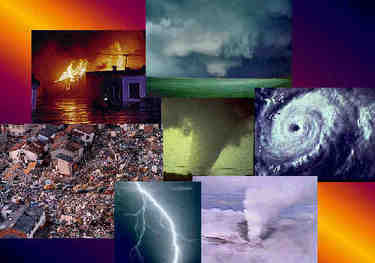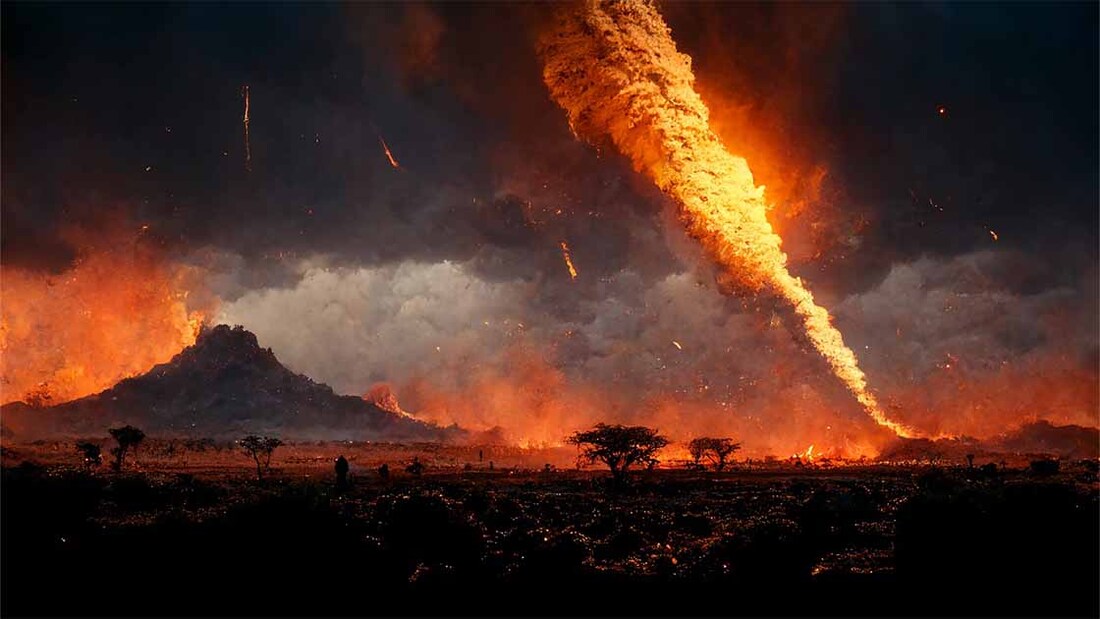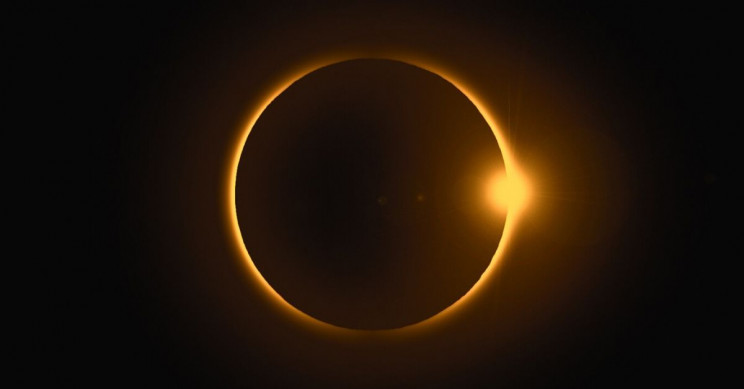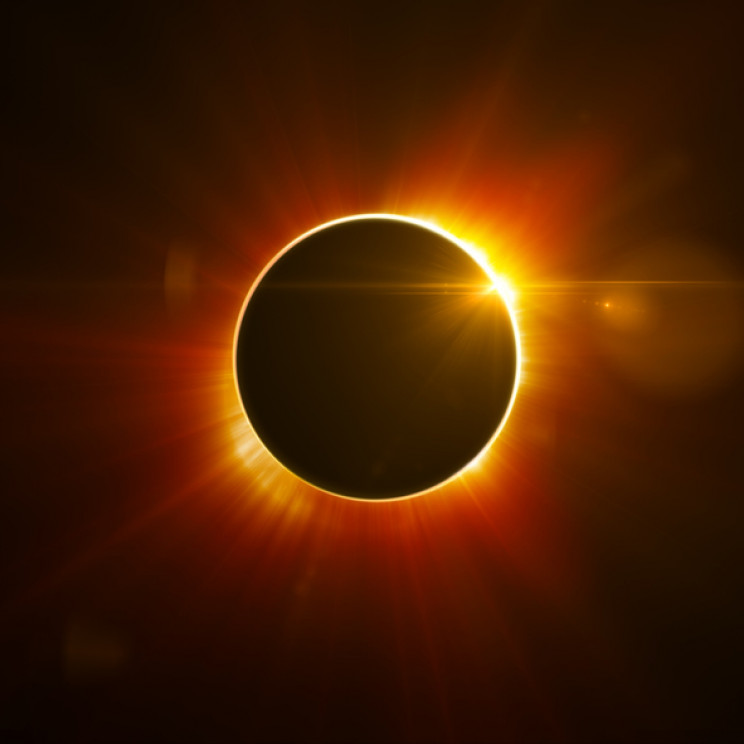|
When studying ancient history, it's sometimes surprising humanity ever made it to the 20th century. Ancient civilizations were repeatedly hit by disasters, both natural and man-made, the likes of which modern civilization has rarely seen. It seems that when nature was trying to wipe us off the face of the map, we were also busy doing it to each other. Here are 7 of the worst disasters to shake the ancient world.
1. The Chicxulub Crater: An Asteroid and a Mass Extinction Event Let’s start with a disaster that predates human civilization by a wide margin, but can confidently be called the greatest natural disaster to have ever shaken the world: the asteroid impact that changed everything. The Chicxulub crater can be found on Mexico’s Yucatan peninsula . Measuring in at 111 miles (180 kilometers) wide and 12.5 miles (20 kilometers) deep, this massive crater marks an asteroid impact from around 66 million years ago. It’s believed that the asteroid was around 6 miles (10 kilometers) in diameter. This may not sound that large, but the speed at which it was traveling meant when it collided with the Earth, it did so with the power of over a billion atomic bombs. Shockwaves were felt around the globe, and winds of up to 600 miles per hour (965 kilometers per hour) scoured the ground surrounding the impact bare. Millions of tons of ash, gases, and debris choked the atmosphere, blocking out the sun and leading to massive global cooling. When this debris began to fall to Earth, it was still so hot that it caused massive wildfires wherever it landed. This all caused an extinction-level event that wiped out up to 75% of all life on Earth during the Cretaceous Period . If this sounds familiar, it is because this is the asteroid strike widely believed to be responsible for the death of dinosaurs. So, really, this is perhaps one we should be grateful for!
0 Comments
Get ready for the last eclipse of 2019 this holiday season.
What a magical time Christmas is! Space now has a gift for us; the last solar eclipse of 2019. Solar eclipse, also known as "ring of fire" eclipse will occur on Thursday, December 26, at 8:17 a.m. GMT+3.
The "ring of fire" will be visible from Saudi Arabia, Qatar, India, Sumatra, Borneo, Guam, and the Philippines. People in other parts of Asia, Australia, and Africa will be able to see a part of the eclipse.
The reason why it's called "ring of fire" is that the eclipse will occur a couple of days after the moon reaches apogee, which is the farthest distance of the moon from Earth, and the size of the moon in the sky will be smaller than the sun. Thus, it won't block the sun entirely, instead, it will block a big part of it and the parts that aren't blocked will look like a "ring of fire."
Solar Eclipse will be visible from Hofuf, Saudi Arabia, it'll last for 2 minutes and 55 seconds, the partial eclipse will begin before sunrise and the annular will begin at 6:34 a.m.
It'll also be visible from Mangalore, India, it will last for 1 minute and 49 seconds, and the partial eclipse will begin at 8:04 a.m. and the annular will begin at 9:24 a.m. Another place that the eclipse will be visible is Jaffna, Sri Lanka, it'll last for 3 minutes and 8 seconds, the partial eclipse will begin at 8:09 a.m. and the annular eclipse will begin 9:33 a.m. Singapore will also be able to watch the Eclipse for 1 minute and 58 seconds. The partial eclipse will begin at 11:27 a.m. and the annular eclipse will begin at 1:22 p.m. In Sarangani, Philippines, the Eclipse will be visible for 2 minutes 25 seconds, and the partial eclipse will begin at 12:44 p.m. and the annular eclipse will begin at 2:29 p.m. Guam will be the last place on Earth to see the eclipse for 3 minutes 4 seconds. The partial eclipse will begin at 3:33 p.m. and the annual eclipse will begin at 4:54 p.m. For those who live in the parts of the world where they can't watch the eclipse, here's a link to watch it online.  Are cosmic rays capable of altering human DNA? Are cosmic rays capable of altering human DNA? By Zach Royer Seventy million years ago, the earth was inhabited by giant reptiles: gigantic lizards, colossal saurains, who slithered, swam, flew. Their reign lasted one hundred million years - whereas, according to the most optimistic estimates, man has had barely six million years. This means that these species of reptiles had in order to become adapted and to evolve, an infinitely longer time than man. Furthermore, it is impossible to pretend that they represented an evolutionary failure: any species that lasts a hundred million years must be considered to be fully adapted. Yet few species that were contemporaries of those reptiles survive -- for example, certain crabs, which have not changed in three hundred million years. In fact, in less than one million years the giant reptiles entirely disappeared. How and Why? We can scarcely maintain that it was because a change in climate; for even when the climate changes, the oceans hardly vary, and many of these reptiles lived in the oceans. It is impossible to believe that a higher form of life was able to exterminate them. This would have required a considerable army, whose traces we would certainly have found. One amusing hypothesis is that our ancestors, the mammals, might have fed on dinosaur eggs. But it is only that: an amusing hypothesis: the icthyosaurs deposited their eggs in the oceans, out of their adversaries' reach. It has been said that the grasses changed, and that the new grasses were too tough for the big reptiles. A completely unlikely hypothesis: large numbers of vegetation types have survived, on which they could have fed perfectly well. The giant tortoises of the Galapagos Islands, the ones that interested Darwin so much, did not die of hunger. One could say that species grow old, become senile, and die. But this is bad logic: the preservation of the genetic code prevents a species from dying out. And why haven't those species that are still living after several hundred millions of years, such as crabs and cockroaches, become senile too? None of these hypotheses hold. But something happened. What then? An ingenious hypothesis has been outlined by two Soviet scientists, V. I. Krasovkii and I. S. Chklovski, both of whom are eminent astrophysicists -- especially the latter, who is the author of some extremely important works in astrophysics and radio astronomy. It was Chklovski, in fact, who studied synchotron radiation and showed that relatively rapid and extremely violent events can be produced at the center of galaxies as well as in space in general. Posted by admin in Earthquakes, Planet Earth This animation shows every recorded earthquake in sequence as they occurred from January 1, 2001, through December 31, 2015, at a rate of 30 days per second. The earthquake hypocenters first appear as flashes then remain as colored circles before shrinking with time so as not to obscure subsequent earthquakes. The size of the circle represents the earthquake magnitude while the color represents its depth within the earth. At the end of the animation it will first show all quakes in this 15-year period. Next, it will show only those earthquakes greater than magnitude 6.5, the smallest earthquake size known to make a tsunami. Finally it will only show those earthquakes with magnitudes of magnitude 8.0 or larger, the “great” earthquakes most likely to pose a tsunami threat when they occur under the ocean or near a coastline and when they are shallow within the earth (less than 100 km or 60 mi. deep).
This time period includes some remarkable events. Several large earthquakes caused devastating tsunamis, including 9.1 magnitude in Sumatra (26 December 2004), 8.1 magnitude in Samoa (29 September 2009), 8.8 magnitude in Chile (27 February 2010), and 9.0 magnitude off of Japan (11 March 2011). Like most earthquakes these events occurred at plate boundaries, and truly large events like these tend to occur at subduction zones where tectonic plates collide. Other, much smaller earthquakes also occur away from plate boundaries such as those related to volcanic activity in Hawaii or those related to wastewater injection wells in Oklahoma. 
(AA) In the wake of the recent string of solar flares, some Americans--particularly Gulf Coast residents--may be wondering whether there are places in the U.S. that are safe from such natural disasters. The short answer? No. The Midwest may not be vulnerable to hurricanes, but twisters drop in regularly. Major earthquakes don't tend to strike New England, but strong winds can peel the roof off a northeastern house and snowstorms can shut down cities.
"Every location in the country is exposed to one disaster or another," says Wendy Rose, spokeswoman for the Institute for Business & Home Safety, a Tampa, Fla.-based nonprofit insurance industry group that aims to reduce losses from natural catastrophes. Still, some places are less susceptible than others to natural hazards. To get an idea where they might be, we partnered with Sperling's Best Places ( www.bestplaces.net), a data collection company based in Portland, Ore. Sperling's has compiled weather and disaster data for 331 metropolitan statistical areas in the U.S., and we used the information to discern the safest--and least safe--areas in which to live. |
News Watch
Mind-opening news articles, editorials, videos & apparel that inspire our readers and help liberate them from the status quo. Stay informed.
Write For UsSpace WatchTop NewsNews Watch Categories
All
|
|
|
HAVE A TIP OR STORY TO TELL? JOIN TODAY & SHARE YOUR STORY!
If you have a breaking news tip or idea, please email: [email protected] Apparently Apparel® is a registered trade name and part of the ZOAT International® brands network. © 2007-2023. All Rights Reserved. Privacy Policy. All art & news content posted on this site is commentary or opinion and is protected under Free Speech. ApparentlyApparel.com is not responsible for content written by contributing artists, authors or news feeds. The information on this site is provided for educational and entertainment purposes only. It is not intended as a substitute for professional advice of any kind. ApparentlyApparel.com assumes no responsibility for the use or misuse of this material.
|
|









